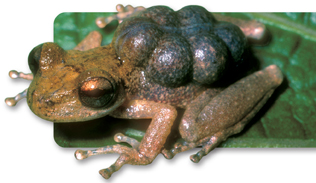Many animals eliminate carbon dioxide by simply using their respiratory systems. However, most complex animals have a specialized organ system—the excretory system—for eliminating other wastes, such as ammonia. The excretory system concentrates or processes these wastes and either expels them immediately or stores them before eliminating them.
Before waste products can be discharged from the body, they must first be collected from cells throughout body tissues and then delivered to the respiratory or excretory system. Some sort of circulatory system is often necessary to perform these functions. So the collection and elimination of wastes requires close interactions between the structures and functions of three body systems, as shown in Figure 25–5 on the previous page.
Reproducing Most animals reproduce sexually by producing haploid gametes. Sexual reproduction helps create and maintain genetic diversity, which increases a species' ability to evolve and adapt as the environment changes. Many invertebrates and a few vertebrates can also reproduce asexually. Asexual reproduction usually produces offspring that are genetically identical to the parent. It allows animals to increase their numbers rapidly but does not generate genetic diversity.

FIGURE 25–6 Reproduction Like many vertebrates, this pygmy marsupial frog is caring for her young while they develop. Unlike most animals, she is carrying her eggs on her back!
25.1 Assessment

-
Review Which characteristics do all animals share?
Classify A classmate is looking at a unicellular organism under a microscope. She asks you if it is an animal. What would you say, and why?
-
Review What is the defining characteristic of invertebrates? What are four characteristics of chordates?
Explain Why would you be unlikely to find a notochord in an adult chordate?
Compare and Contrast How do vertebrates differ from other chordates?
-
Review Describe the essential functions performed by all animals.
Explain Why must waste products produced by metabolic processes be eliminated from an animal's body?
Sequence Which body system delivers waste products to the respiratory and excretory systems?
VISUAL THINKING
Make a two-column chart that lists the ways that animals gather and respond to information. In the first column, list each function. In the second column, include a drawing, photograph, or clipping of a structure that performs that function.

Table of Contents
- Formulas and Equations
- Applying Formulas and Equations
- Mean, Median, and Mode
- Estimation
- Using Measurements in Calculations
- Effects of Measurement Errors
- Accuracy
- Precision
- Comparing Accuracy and Precision
- Significant Figures
- Calculating With Significant Figures
- Scientific Notation
- Calculating With Scientific Notation
- Dimensional Analysis
- Applying Dimensional Analysis




